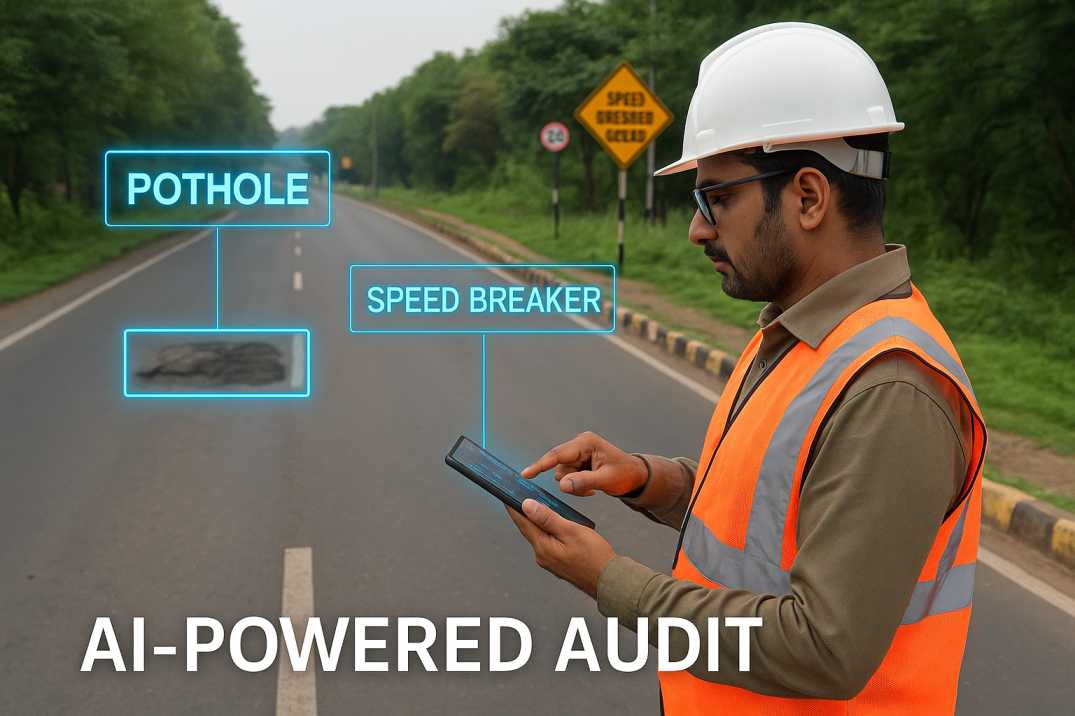Contact Us
RoadVision AI
Private Limited
Office No. 308 & 310, B Block
Ansal Chamber - 1, Bhikaji Cama Place,
Near Engineers India Limited (EIL) Bhawan, New Delhi - 110066
© 2024 | RoadVision AI | All rights reserved
India’s roads carry one of the heaviest traffic loads in the world, and ensuring their safety requires strict adherence to standards like IRC SP:99. This standard provides a comprehensive framework for conducting road safety audits in India, covering design, construction, and post-construction phases. However, traditional manual audits can often miss critical signs of failure. That’s where AI road asset management, predictive maintenance, and blackspot identification in India come into play.
With tools like RoadVision AI, safety audits are no longer reactive. They’re proactive, data-driven, and precise. In this blog, we explore the top 7 common road safety risks highlighted in IRC SP:99 and how AI road hazard detection and pavement monitoring tools identify them early to prevent catastrophic outcomes.

Problem: Inadequate visibility on bends and intersections is one of the most dangerous issues, leading to delayed driver response and increased crash risk.
IRC SP:99 Guidance: Calls for measurement of stopping sight distance (SSD) and overtaking sight distance (OSD) across various design stages.
How AI Helps: AI-powered platforms like RoadVision AI's Road Safety Audit module use geotagged video data and computer vision to measure and validate actual sight distances against required values from standards.
Problem: Signage that is faded, obstructed, wrongly placed, or missing entirely creates confusion and accidents.
IRC SP:99 Guidance: Mandates correct placement, size, and visibility of all regulatory and warning signs.
How AI Helps: RoadVision’s road inventory inspection system automatically detects and classifies signs, flags missing signage, and checks compliance with IRC standards.
Problem: Unsafe horizontal curves, steep gradients, or improper superelevation lead to vehicle skidding and rollover incidents.
IRC SP:99 Guidance: Recommends detailed review of cross-sections, horizontal curves, camber, and gradient.
How AI Helps: With LiDAR and image-based elevation mapping, AI can detect non-standard curves and gradients and recommend geometric corrections well in advance.
Problem: Poor visibility of lane markings contributes to lane discipline violations and head-on collisions.
IRC SP:99 Guidance: Emphasizes uniformity and retro-reflectivity of pavement markings.
How AI Helps: Through continuous pavement condition surveys, RoadVision flags faded markings, recommends repainting, and helps maintain safe driving environments.
Problem: Improperly constructed or unmarked speed humps cause accidents, particularly to two-wheelers and night-time drivers.
IRC SP:99 Guidance: Specifies height, placement, and signage requirements for traffic calming measures.
How AI Helps: Using video analytics and 3D reconstruction, AI systems can identify illegal or non-standard speed breakers and notify authorities.
Problem: Absence of footpaths, crossings, and pedestrian signals endangers non-motorized road users.
IRC SP:99 Guidance: Mandates pedestrian refuge islands, zebra crossings, and safe walkways.
How AI Helps: AI detects pedestrian movement patterns, identifies unsafe zones, and evaluates pedestrian infrastructure coverage for urban and rural roads.
Problem: Cracks, potholes, rutting, and other distresses not only reduce ride quality but also increase accident probability.
IRC SP:99 Guidance: Audits must evaluate pavement condition, severity of defects, and schedule timely repairs.
How AI Helps: AI-based pavement monitoring tools detect alligator cracks, potholes, and edge failures using smartphone-based or dashcam-based video input, enabling predictive maintenance and lifecycle planning.
Traditional audits rely heavily on human observation, prone to inconsistency and delay. AI ensures:
By integrating AI with IRC SP:99 frameworks, authorities and consultants can conduct more audits with greater accuracy and at lower cost.
The stakes in road safety have never been higher. With increasing traffic and urbanization, compliance with IRC SP:99 is no longer optional—it is essential. AI-powered road asset management systems like RoadVision are already transforming how India audits, maintains, and improves its roads.
RoadVision AI is revolutionizing road infrastructure development and maintenance with its innovative solutions powered by computer vision AI. By leveraging advanced technologies, the platform conducts comprehensive road condition monitoring and traffic surveys, enabling early detection of surface issues like potholes and cracks for timely repairs and enhanced roads. Through traffic congestion analysis, RoadVision AI provides data-driven insights to address traffic congestion challenges and optimize road usage. With a focus on building smarter and more efficient roads and highways, RoadVision AI ensures full compliance with IRC Codes, helping engineers and stakeholders reduce costs, minimize risks, and improve road safety and transportation efficiency.
If you’re a road authority, consultant, or infrastructure planner looking to streamline safety audits and cut maintenance costs, AI is your most powerful ally.
Book a demo with RoadVision AI and see how our platform ensures IRC SP:99 compliance while saving time and money.
Q1. What is IRC SP:99 and why is it important?
IRC SP:99 is the Indian guideline for conducting road safety audits. It ensures roads are designed and maintained to reduce accident risks.
Q2. Can AI help identify accident-prone areas?
Yes. AI tools analyze crash data and road geometry to enable early blackspot identification and improve safety planning.
Q3. What kind of roads can be audited using RoadVision AI?
From national highways to rural roads, AI can audit all types of roads with scalable solutions that ensure full IRC compliance.